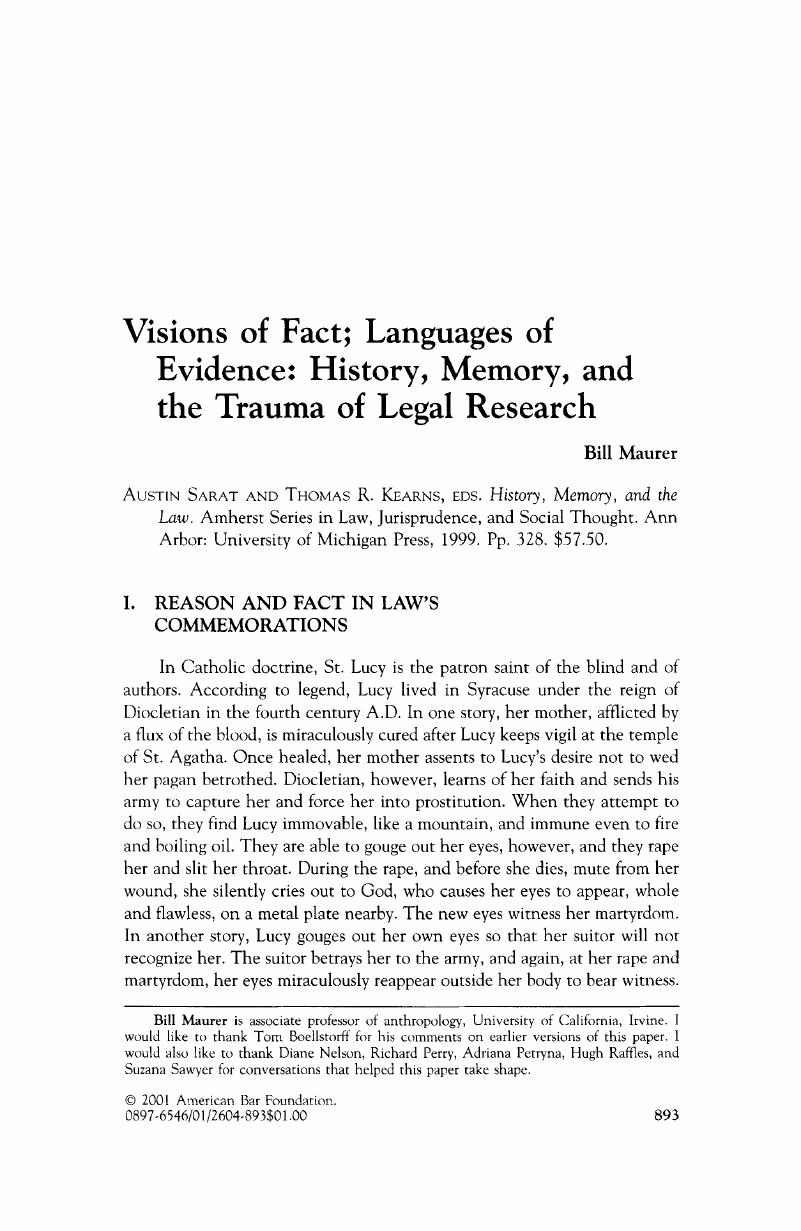No CrossRef data available.
Article contents
Visions of Fact; Languages of Evidence: History, Memory, and the Trauma of Legal Research
Published online by Cambridge University Press: 27 December 2018
Abstract
An abstract is not available for this content so a preview has been provided. Please use the Get access link above for information on how to access this content.

- Type
- Review Article
- Information
- Copyright
- Copyright © American Bar Foundation, 2001
References
Burton, David M.
1985. The History of Mathematics: An Introduction. Boston: Allyn and Bacon.Google Scholar
Caruth, Cathy.
1988. The Force of Example: Kant's Symbols. Yale French Studies
74:17–37.Google Scholar
1991. Unclaimed Experience: Trauma and the Possibility of History. Yak French Studies
79:181–92.Google Scholar
Collier, Jane, Maurer, Bill, and Suarez-Navaz, Liliana. 1995. Sanctioned Identities: Legal Constructions of Modern Personhood. Identities: Global Studies in Culture and Power
2 (1 & 2):1–27.Google Scholar
Daston, Lorraine.
1988. Classical Probability in the Enlightenment. Princeton, N.J.: Princeton University Press.Google Scholar
1991. Marvelous Facts and Miraculous Evidence in Early-Modern Europe. Critical Inquiry
18(1):93–124.Google Scholar
Dear, Peter.
1995. Discipline and Experience: The Mathematical Way in the Scientific Revolution. Chicago: University of Chicago Press.Google Scholar
Deleuze, Gilles, and Guattari, Félix. 1983. The Anti-Oedipus: Capitalism and Schizophrenia. Minneapolis: University of Minnesota Press.Google Scholar
de Man, Paul.
1986. The Resistance to Theory. Minneapolis: University of Minnesota Press.Google Scholar
Foucault, Michel.
1983. This Is Not a Pipe. Berkeley and Los Angeles: University of California Press.Google Scholar
Latour, Bruno.
1993. We Have Never Been Modern. Cambridge, Mass.: Harvard University Press.Google Scholar
Lempert, Richard.
1988. The New Evidence Scholarship. In Probability and Inference in the Law of Evidence: The Uses and Limitations of Bayesianism, ed. Tillers, P. and Green, E.
Boston: Kluwer Academic.Google Scholar
Mertz, Elizabeth. Forthcoming. The Perfidy of the Gaze and the Pain of Uncertainty: Anthropological Theory and the Search for Closure. In Transforming States, ed. Greenhouse, Carol, Mertz, Elizabeth, and Warren, Kay, Durham N.C.: Duke University Press.Google Scholar
1996. Recontextualization as Socialization: Text and Pragmatics in the Law School Classroom. In Natural Histories of Discourse, ed. Silverstein, M. and Urban, G., pp. 229–49. Chicago: University of Chicago Press.Google Scholar
Poovey, Mary.
1998. A History of the Modern Fact: Problems of Knowledge in the Sciences of Wealth and Society. Chicago: University of Chicago Press.Google Scholar
Sarat, Austin, and Keams, Thomas R.
1992. A Journey Through Forgetting: Toward a Jurisprudence of Violence. In Law's Violence, ed. Sarat, A. and Kearns, T.
Amherst Series in Law, Jurisprudence, and Social Thought. Ann Arbor: University of Michigan Press.Google Scholar
Seigel, Michael L.
1994. A Pragmatic Critique of Modern Evidence Scholarship. Northwestern University Law Review
88: 995–1045.Google Scholar
Shapin, Steven, and Schaffer, Simon. 1985. Leviathan and the Air-Pump: Hobbes, Boyle, and the Experimental Life. Princeton, N.J.: Princeton University Press.Google Scholar
Shapiro, Barbara.
1991. “Beyond Reasonable Doubt” and “Probable Cause”: Historical Perspectives on the Anglo-American
Law of Evidence. Berkeley and Los Angeles: University of California Press.Google Scholar
Sichel, Berta.
1997. Commentary on Kim Stringfellow. Urban Desires
3(1). Available at >http://www.desires.eom/3.1/3.1_toc.html<, last accessed 11 July 2001.http://www.desires.eom/3.1/3.1_toc.html<,+last+accessed+11+July+2001.>Google Scholar
Silverstein, Michael.
1976. Shifters, Linguistic Categories, and Cultural Description. In Meaning in Anthropology, ed. Basso, Keith and Selby, Henry. Albuquerque: University of New Mexico Press.Google Scholar
Silverstein, Michael, and Urban, Greg. 1996. The Natural History of Discourse. In Natural Histories of Discourse, ed. Silverstein, M. and Urban, G., pp. 1–17. Chicago: University of Chicago Press.Google Scholar
Strathern, Marilyn.
1985. Discovering Social Control. Journal of Law and Society
12:111–34.Google Scholar
Toulmin, Stephen.
1958. The Uses of Argument. Cambridge, England: Cambridge University Press.Google Scholar
Tribe, Laurence.
1971. Trial by Mathematics: Precision and Ritual in the Legal Process. Harvard Law Review
84(6):1329–93.Google Scholar
Twining, William.
1994. Rethinking Evidence. Evanston, Ill.: Northwestern University Press.Google Scholar
West, Robin.
1991. Disciplines, Subjectivities, and the Law. In The Fate of Law, ed. Sarat, A. and Kearns, T.
Ann Arbor: University of Michigan Press.Google Scholar
Weston, Nancy A.
1997. The Fate, Violence, and Rhetoric of Contemporary Legal Thought: Reflections on the Amherst Series, the Loss of Truth, and the Law. Law and Social Inquiry
22 (3):733–808.Google Scholar
Wigmore, J. [1913] 1988. The Principles of judicial Proof. Littleton, Colo.: F. B. Rothman.Google Scholar




